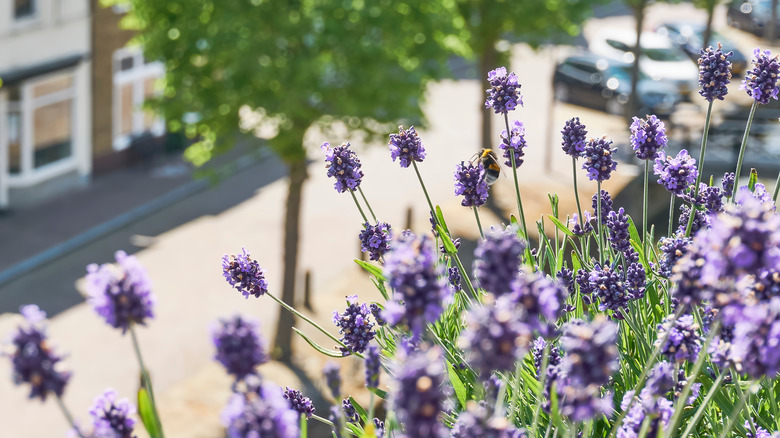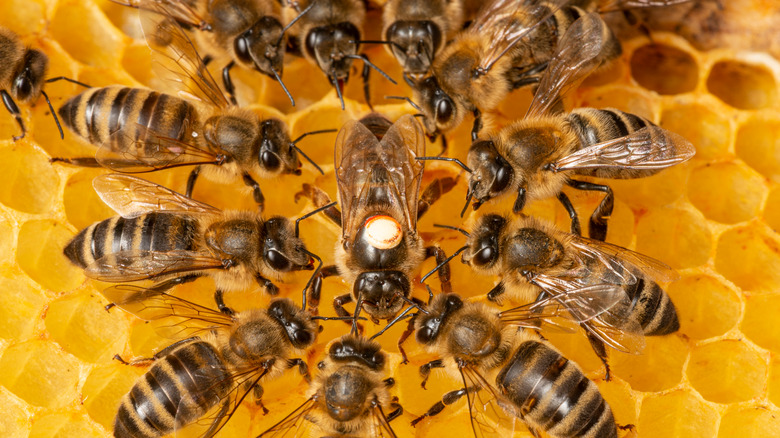The Unexpected Perk That's Trending For Sustainable Real Estate
It's a known fact that bees are a vital component of our ecosystem. Fruits, vegetables, and flowering plants rely on the busy buzzy pollinators so they can reproduce. The latest benefit that bees deliver is the ability to harvest their honey within residential real estate. According to New York Post, beehives are a must-have green amenity, especially in urban areas like New York City. Here bees can produce honey for occupants while including the attraction of seasonal birds. Places like The Solaire in Battery Park endow a jar of honey to prospective buyers when they partake in a tour of their luxurious residences along the Hudson River. The director of sales, Aaron Goed, has said that the residents love the sustainable feature along with it providing a personal correlation to nature.
According to the Department of Health and Hygiene, NYC's registered hive numbers have increased into the hundreds as they continue to develop. With businesses and overall cities becoming more eco-friendly, urban agriculture is also on the rise. Parks, backyard landscapes, citified trees, and median strips offer a wide variety of pollen-bearing potential to administer honey harvesting. Why are bees so important? The honey-making insects are the top pollinators for food crops which cover a wide range of products that we use daily. Honeybees produce a plethora of resources like honey, oil, and raw materials, including providing nourishment for wildlife and preventing soil erosion. Read on to learn more about the benefits of bees!
The importance of bee pollination in an urban landscape
There's no doubt we need bees for our planet to thrive. With continuing threats like intensive farming and the overuse of pesticides, our sweet friends face the loss of their usual pollinating habitat. Within cities like New York, Houston, and San Francisco, real estate development is attempting to reduce that risk by incorporating more garden-level rooftop gardens on new or old renovated buildings, per Best Bees. Best Bees Staff Scientist Emily O'Neil has said that urban bee habitats should be organic while integrating an assortment of flower/plant life. Another environmentally conscience residence, Helena 57 West, maintains seven hives on a 5,000-square-foot rooftop park. Along with other green amenities like air-filtration systems, this posh Hell's Kitchen apartment building successfully produces an ample amount of honey with the help of beekeeper Andrew Cote, who yields and distributes honey jars to their residents (via New York Post).
Let them be. With urban beekeeping increasing worldwide, some might disagree that citified hives are becoming unsustainable. According to NPJ Urban Sustainability, with beehive growth in London, Paris, and various Swiss cities, bees might find a limited amount of urban flowers to sustain them while creating added pressure on other pollinators. Attracting too many honeybees with not enough pollinator-friendly plant life administers an imbalance of productivity for them. The answer might be to intensify more green areas throughout cityscapes, although with an excess of hives present, the space between them can also become restrictive.
The sweet benefits of honeybees
With more than 20,000 species of bees globally, the honeybee is the most recognized, as it produces several hive products like beeswax, honey, pollen, propolis, royal jelly, and venom. Honey remains a substantial product, with a conglomerate of health and medical benefits such as antioxidants, antibacterial/antifungal properties, nutrients, immune-boosting, wound healing, digestive aid, and brain health (helps with memory). Without bees, we would also lack many of our favorite and/or necessary products like almonds, coffee, and chocolate. They are responsible for assisting in the production of 1/3 of the world's food crops, per Friends of the Earth. A type of chain reaction, their work affects other food sources we consume like milk and beef, thus assisting cattle with their food supply like alfalfa.
Plants can develop when the transfer of pollen occurs between the male portion of a flower (anther) and the female part (stigma). According to Premier Tech, bees move from flower to flower, seeking nectar while emitting small granules of pollen on the tacky surface for the plants to propagate. House bees place the nectar inside the honeycomb, then dry it with the wind from their wings. Sealing it like a jar themselves, they come back in the winter to indulge. So vital, without the work of our planet's honeybees, certain crops would perish. In addition to the millions of agricultural crops bees pollinate each year, they also support the growth of trees and plant life, allowing our ecosystems to function properly.


